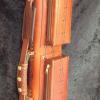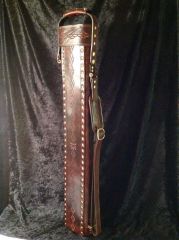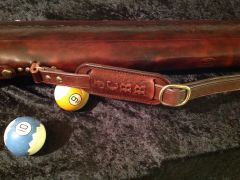-
Posts
252 -
Joined
-
Last visited
Content Type
Profiles
Forums
Events
Blogs
Gallery
Everything posted by RiverCity
-

Help Choosing The Right Cylinder Machine
RiverCity replied to Cmoore's topic in Leather Sewing Machines
The cowboy 227 is a great machine. Plenty of power for the leather you are working with, and a ton of accessories available for it. Chuck -
Smaller hands usually find smaller barrels more comfortable. A 3/8 barrel, with a 1/4 or 3/8 blade would be a good place to start. If you have access to other people who have tools, try some different sizes if you can before buying. Chuck
-

Floral Briefcase With Dyed Background
RiverCity replied to Double U Leather's topic in Satchels, Luggage and Briefcases
Very nice! Chuck -
Bought from them, they don't include COOL info. They might be able to if you call them, but it's from the Herman oak tannery in MO. As far as paypal, they probably just don't offer it as it costs more to accept payment, than their EFT system already in place. Chuck
-
There's things you can do to eliminate stretch, but as everyone has said it's not worth it. Puts both of you at risk should something fail. Chuck
-
Here's one I made as a get well gift for an old friend. He wanted me to make him a case, but he went to the emergency room a couple weeks ago, and had to have surgery immediately for a ruptured intestine. With his medical bills piling up, I wanted to surprise him. It's going in the mail tomorrow no charge. Chuck
-

Hinges For Semi Rigid Cases
RiverCity replied to Procyon650's topic in Satchels, Luggage and Briefcases
You can add strength to the leather by sandwiching a nylon web strap between two layers of thinner leather, narrower than the leather itself. You want to see leather only on the edges, but the webbing is glued and sewn into place. Very strong option. Chuck -
Practice. A lot. Tips to be more successful, avoid cutting in thumb prints if at all possible. When you do, you need to take into account what plane the leather is facing, and tilt your blade to be perpendicular to it. Keeping your knife straight up and down will lead to undercuts. Moisture content, you want the color to have returned, but still be wet. Since it is a last touch kinda thing, if you must rewet the leather, wait until the natural color comes back before cutting. But seriously, practice practice practice. If the thumbprint cuts are your hardest, hit a bunch of thumb prints and pear shaders on some scrap and practice those cuts specifically. Look at some of the better leather carvers work. See where they stop their shading in flower petals etc, and where the cuts are. Hope this helps. Chuck
-

Marble Effect?
RiverCity replied to wearthefoxhat's topic in Dyes, Antiques, Stains, Glues, Waxes, Finishes and Conditioners.
I do a mottled/marble effect with a technique similar to sponge painting using rags. I dye the piece trying to get it close to being even, but don't sweat it if you have a few darker spots. Then blot spots here and there with a rag wet with dye. In the other hand I have a dry rag and quickly blend it a little around the edges. There's no substitute for just playing around and seeing what you can come up with. Chuck -

Spray Setup
RiverCity replied to Red Cent's topic in Dyes, Antiques, Stains, Glues, Waxes, Finishes and Conditioners.
The cheapo 9 buck harbor freight gun. I posted a pic earlier in the thread. It has no problem laying down light coats of dye or acrylic. Chuck -
Needle nose pliers. Grab the old one at the bottom and pull towards the handle. Use the pliers to put the new one in too, grab at bottom of blade with the pliers and slide it up and in on the channel in the skiff handle. Hope this helps. Chuck
-

Spray Setup
RiverCity replied to Red Cent's topic in Dyes, Antiques, Stains, Glues, Waxes, Finishes and Conditioners.
I disagree. If you're just dying wallets and the like then yes, an airbrush would be sufficient. Covering large areas the gun is more than fine. The guns are adjustable, there isn't much overspray at all. I spray dye all of my cases (50-50 or less dye than that sometimes) when an even color is asked for. I hand dye only when I want a mottled color. And as for acrylics/resolene, again, 50-50 and there is no problems laying down light coats. I've used this system for months with zero problems. The middle case is hand dyed, he wanted an antique look, the other cases were gun dyed. And all of them were gun finished. Chuck -
Very nice! Chuck
-

Some Cases I've Been Working On
RiverCity replied to RiverCity's topic in Satchels, Luggage and Briefcases
Thanks! I don't know if I'll ever feel like I've made a perfect case, but the challenge of trying is a driving force. On that one, I still made money over material cost, but labor wise was probably 4 bucks an hour.... Lol I used to hand sew wallets and stuff when I was a kid. Couldn't stand it then, can't stand it now... Lol. It's a do it only if I have to venture. I bought a cowboy stitcher a while back that has been a life and hand saver. Before I got the machine I had a guy wanting pockets. I told him no problem, then quoted him the price based on my dislike for hand sewing. He went pocketless... Thanks! Chuck -

Some Cases I've Been Working On
RiverCity replied to RiverCity's topic in Satchels, Luggage and Briefcases
Thanks. To answers your question.... Waaaay too long lol. 30-40 hours on a non carved case. I'm working on one right now and I've got 10 hours just in drawing the pattern so far. Keep at it, it's just a matter of practice and looking for things to improve on. Every case I build is better than the last. When I compare the cases I'm making now to the first one, it's night and day. Never get comfortable with the level of quality you are putting out, cause as soon as you say that's good enough... It won't be. Here is a case I cut off the guts cause I wasn't happy with it. 50-60 bucks in leather and materials and several hours in the trash can. Chuck -
-
-
Airbrush Chuck
-
From the album: Chuck Fields Leather Works
-
From the album: Chuck Fields Leather Works
-
From the album: Chuck Fields Leather Works
-
From the album: Chuck Fields Leather Works
-
You can't go wrong with Kevin Hopkins and Springfield leather. Chuck
-
Leather balm with atom wax. It won't be 100% water proof! but it will be very water resistant. Chuck





















